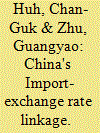| Srl | Item |
| 1 |
ID:
130973


|
|
|
|
|
| Publication |
2014.
|
| Summary/Abstract |
This paper examines how the China-bound exports of Japan and Korea are related to exchange rates, motivated by the fact that processing trade makes up a large proportion of China's trade, and that Japan and Korea are the leading source countries for processing imports. Because processing imports are inputs for exports, the link between such imports and China's exchange rates are ambiguous. We estimate export functions that include China's RMB real effective exchange rates (REER) along with bilateral real exchange rates (BRER) using Johansen's cointegration method and find that the RMB REER significantly affects Japanese and Korean exports to China, even more so than BRER in most cases examined. These two exchange rates appear in the export equations with opposite signs. Subsequently, we use the estimated model to illustrate the importance of accounting for a concurrent change in BRER when analyzing the effects of a hypothetical RMB revaluation on China's trade balances despite the apparently weak imports-BRER linkage.
|
|
|
|
|
|
|
|
|
|
|
|
|
|
|
|
| 2 |
ID:
130535


|
|
|
|
|
| Publication |
2014.
|
| Summary/Abstract |
The increasing share of imported food in developed countries, such as the U.S. and European Union countries, poses new challenges for food safety and quality regulators. China as the world's biggest food producer has the fastest growing share of fish and shellfish exports to these countries. While there have been an increasing number of studies conducted on consumer demand for various food product attributes, little research has been focused on producer behavior, and studies on Chinese food producers are especially absent in the literature. The objective of this study is to assess Chinese aquaculture producers' willingness-to-change (WTC) and adopt certain production practices related to food safety. Producer preferences for enhanced food safety measures, and sustainable/eco-friendly production practices are assessed using a choice experiment. Primary data was collected in the leading aquaculture producing provinces of southern China. The average net income per farmer of our sample was 81,286 RMB/year of which approximately 72% originated from their aquaculture operation. Derived WTC estimates from a random parameters logit model suggest that the representative Chinese producer would require a 2.49% premium per jin of fish to adopt enhanced food safety practices such as those required for China GAP, and No Public Harm voluntary certifications and they would accept a 3.22% discount before being indifferent between having an antibiotic-free facility and using antibiotics. WTC estimates of sustainable eco-friendly practices and verification by various entities were also assessed. A latent class model (LCM) is used to segregate producers into group with similar underlying characteristics to develop policies to improve producer practices and ultimately product safety and quality.
|
|
|
|
|
|
|
|
|
|
|
|
|
|
|
|